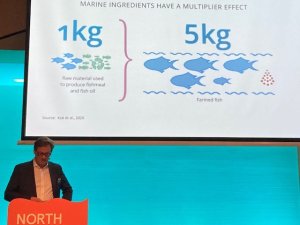 IFFO's Director General Petter Johannessen was among the speakers* at the North Atlantic Seafood Forum's Aquaculture Feed Summit, where he presented why marine ingredients are a sustainable platform for healthy food for the future.
IFFO's Director General Petter Johannessen was among the speakers* at the North Atlantic Seafood Forum's Aquaculture Feed Summit, where he presented why marine ingredients are a sustainable platform for healthy food for the future.
All speakers emphasized the much needed role of dialogue and connection throughout the aquatic food system value chain in order to nourish billions and tackle the many challenges, from population growth to energy shocks and climate change. With seafood production expected to increase by 32% by 2030, 40 million tonnes of additional ingredients are needed, according to Skretting, who started the session.
Due to the strategic use of marine ingredients in aquaculture today, 1 kg of marine raw materials forms the basis for the production of 5 kg farmed fed seafood: "an incredible multiplier effect, and one which illustrates the true importance of fishmeal and fish oil to global farmed seafood production" Petter Johannessen insisted.
Second main message shared by all speakers was about circularity: there is no such thing as waste. Veramaris started their presentation quoting the FAO figure according to which 35% of all fish, crustaceans, molluscs harvested from oceans, lakes and fish farms are wasted before they reach consumers' plates. Waste of fish means a waste of feed. Most importantly, EPA/DHA is key to reducing waste by the fact that the fish health improves and mortality (loss of biomass) is reduced, Veramaris insisted. Furthermore, the by-products from healthy fish make excellent raw material for marine ingredients, Petter Johannessen added.
Marine ingredients come from a variety of raw materials, with two thirds coming from forage fish, which have a very limited direct food market, and by-products, trimmings from processed fish. Once processed into fishmeal and fish oil, they can be used strategically in feed to produce many more times the volume of more widely accepted and consumed fish and other animal protein in a very efficient way. The increasing use of by-products is providing an essential additional raw material source that supports the increased volume of feed required for the aquaculture industry. By-products may constitute up to 70% of fish and shellfish after processing (fish fillet yield is species-dependent and is often in the range of 30 -50% of the fish).
When we look separately at fishmeal and fish oil, we find that the global production of fishmeal from by-products accounts for 29.8%, while fish oil output from by-products represents 51% of the total fish oil production. The higher value compared to fishmeal is due mainly to the high oil yields of salmon and pangasius trimmings.
Life cycle assessments of feed ingredients were a core topic throughout the event, and are now recognised as a key driver to help decision making.
"We all are aware of the importance of understanding the footprint of our activities. All activity and production will leave a footprint and we need to understand the factors that give this footprint to be able to mitigate and improve" Johannessen stressed. Life Cycle Assessment (LCA) aims to compare the full range of environmental effects assignable to products and services by quantifying all inputs and outputs of material flows and assessing how these material flows affect the environment. By joining the Global Feed LCA Institute, GFLI, IFFO is contributing to a public database which allows for cross sectoral comparisons.
If we focus on one of the 16 parameters that are covered by the GFLI database, carbon footprint, we can see that all main sources of small pelagics perform very well. The Peruvian anchovy is less than 8 percent of the CO2 emissions related to land-based ingredients such as SPC (over 90 percent). Marine byproducts performing very strongly as well.
Last but not least: nutrition. Much was said about the necessary balance between omega3s and omega6s in our diets and the many benefits provided by EPA and DHA, as demonstrated by numerous papers such as NOFIMA's. In addition to these crucial nutrients, amino acids and vitamins also play a key role in improving fish health and contributing to what the human body needs to develop and stay healthy.
Marine ingredients are more and more used as strategic ingredients due to the fact that they create a solid nutritional platform for fed aquaculture. Fishmeals are the ideal nutritional package, rich in proteins, essential amino acids and various other micronutrients. While fish oil remains the world’s most cost-effective source of long-chain omega-3 fatty acids.
* Speakers at the Aquaculture Feed Session included:
Christian Meinich, CEO Holtermann, Chairing the session, May Helene Holme, Innovation Director, Skretting AS, Helene Ziv-Douki, President and Group leader, Cargill Aqua Nutrition, Carlos Mera, Analyst- Head of Agri Commodities Markets, RaboResearch / Rabobank, Ian Carr, Global Business Development Director Veramaris, Sigve Nordrum, EVP Animal Health & Nutrition Aker Biomarine, Medhi Berrada, CEO and co-founder Agronutris, Petter Johannesen, CEO IFFO, Pablo Berner, Aquaculture Business Lead, Nuseed, Ruud Peerbooms, President of Algae Ingredients, Corbion








